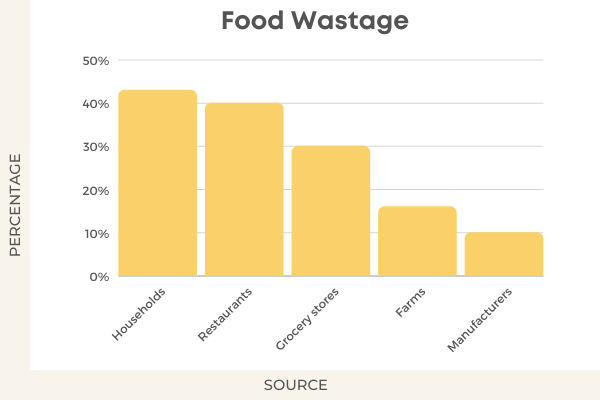The United States generates high amounts of food waste on a yearly basis. A couple of years ago, the US was ranked as the second most wasteful country in the world right after Australia.
Now, in 2022, the situation hasn’t changed and the United States produces even more wastage now. And that is a big problem.
How much food waste is produced in the United States on a daily, monthly, and yearly basis? How much food is wasted in supermarkets and restaurants? Do US households also produce high amounts of food waste? What can be done regarding this problem?
In today’s article, we’ll cover all the mentioned questions and more in order to give you all the info and statistics about this massive problem. Just keep on reading and find out all the details you need to know!
8 Key American Food Waste Statistics (Editor’s Pick)
- 108 billion pounds of food is wasted in the United States every year.
- 130 billion meals are wasted on a yearly basis.
- The amount of wasted food is enough to feed 25 million Americans.
- US households waste 19.4 million tonnes of food every year.
- US retail stores generate 16 billion pounds of food waste.
- Food waste results in more than 20% of wasted water.
- Hawaii wastes 26% of the state’s entire food supply.
- In 2020, Feeding America rescued 4.7 billion pounds of groceries.
28 American Food Waste Statistics
1. Americans waste 40% of the food.
Every year, Americans waste nearly 40% of all food. That means that almost half of the produced food isn’t consumed but thrown into the trash. According to the data by Feeding America, 108 billion pounds of food is wasted in the United States on a yearly basis. And that amount could feed millions of people fighting food insecurity and hunger.


Source: Feeding America
2. About 130 billion meals end up in the trash.
The mentioned percentage of wasted food presents 130 billion meals and it is estimated to be worth more than $408 billion. We can say that all those billions of dollars were simply thrown into the trash. According to Feeding America, the food goes to waste at every stage of food production and distribution. That included farmers, packers, and shippers, as well as manufacturers, and retailers.
Source: Feeding America
3. Every person wastes 219 pounds of food.
The fact that almost 50% of the entire US food supply eventually gets wasted is rather shocking. This high amount of wasted food is equal to 219 pounds of waste per person. Such wastes usually happen because of the expiration date, picky eating, throwing out leftovers, and other similar factors which contribute to throwing away perfectly edible food.
Source: Food and Agriculture Organization
4. Most food waste ends up in landfills.
To present a better-looking picture of the food waste problem, we could say that the amount of food waste per person would be like as if every American throws out more than 650 oversized apples right into the garbage – perfectly edible, just bought apples. But the problem doesn’t end here – most food waste actually ends up in landfills. Food is the single largest component that is taking up space inside US landfills. The food there accounts for more than 24% of municipal solid waste.
Source: Food and Agriculture Organization and United States Department of Agriculture
5. American food waste would feed 25 million people.
The amount of wasted food in the United States would be enough amount to feed 25 million Americans. Or to put it more clearly – such an amount of food would be enough to feed the entire population of Texas. When you think about how millions of Americans are fighting food insecurity and hunger, the mentioned numbers are rather shocking.


Source: Sustainable America
6. More than 80% of wasted food is perfectly good and edible.
According to the report by RTS, more than 80% of Americans discard perfectly good and edible food. One of the main reasons why they throw out such food is misunderstanding expiration labels. The labels such as “use by”, “expires on”, “best before”, “best by”, and “sell by” are confusing to the people and most of the time, they throw away such food because they don’t want to risk the potential of a foodborne illness.
Source: RTS
7. Around 35% of the available food is unsold and uneaten.
According to the data provided by ReFED, 35% of the 229 million available food goes unsold and uneaten. And that number of wasted food is valued, as we already mentioned, at $408 billion. Such food would save many lives and make a significant improvement in the global fight against hunger and malnutrition.
Source: ReFED
8. One pound of food per person is wasted on a daily basis.
Every day, up to one pound of food per person is wasted. That means that 103 million tons (or 206 billion pounds) of food is wasted in the United States. Due to that, no wonder that almost 50% of the food supply is wasted while being perfectly edible, good, and healthy.
Source: United States Department of Agriculture
9. About 218 pounds of food are wasted per person every year.
If we look at the situation of food waste on a monthly basis, every person wastes about 20 pounds of food. That equals 45 bananas or 2 whole turkeys or 16 potatoes thrown away into the trash every single month. According to Future Farmers of America, on a yearly basis, around 218 pounds of food are wasted per person in the United States.
Source: Sustainable America and Future Farmers of America
10. About 133 billion pounds of food waste equals 1,249 calories per person per day.
According to the data by The Conversation, Americans have 133 billion pounds of food waste every year. That amount of wasted food represents 1,249 calories per person, per day. All the people in the country would have enough food and no fear of food insecurity if only this amount of food isn’t thrown out on a yearly basis.
Source: The Conversation
11. Restaurants and markets produce 40% of food waste.
Food is wasted from a lot of different sources, but they are all connected in the supply chain. According to data provided by RTS, most waste comes from households, or to be more precise, 43% of the food. Restaurants, grocery stores, and food service companies are to blame for up to 40% of food waste, while farms produce 16% of food waste. Manufacturers produce the least waste – only 10%.


Source: RTS
12. Uneaten food is worth $161 billion.
The economy is hit rather hard by the great amounts of food waste. The Conversation data stated that retailers, restaurants, and homes lose $161 billion of uneaten food. Such wastage can be fatal for many businesses since their financial status will be massively impacted by the difference between costs and revenue.
Source: The Conversation
13. Restaurants produce 600,000 tons of food waste.
According to a study conducted by the University of Arizona, 9.55% of wasted food comes from fast-food restaurants, while 11.3% is wasted in restaurants with full service. To be more specific and precise, about 600,000 tons of food waste comes from restaurants. There are a couple of reasons why food gets wasted in restaurants – food wasted during meal preparation, ruined or expired products, leftovers, and packaging waste.
Source: The University of Arizona and 911 Chef Eric
14. The US fast-food industry produces more than 32 billion pounds of food waste.
The fast-food industry in the United States is the biggest fast-food industry in the world. The average fast-food restaurant generates 200,000 pounds of food waste per year. According to Statistic Brain, that would mean that the fast-food industry in the US generates more than 32 billion pounds of food waste. And we’re only talking about fast food restaurants here.
Source: Statistic Brain
15. McDonald’s generates 90,000 tons of food waste.
McDonald’s produces quite a high amount of food waste. According to AskingLot, at least 47 million people eat at McDonald’s every day so it shouldn’t be a surprise that McDonald’s produces the most waste in the fast-food industry. The restaurant generates 90,000 tons of wood waste every year. That amount of food waste costs $1.3 billion.


Source: AskingLot
16. US households waste the most food.
Speaking of different sectors, households are responsible for the largest portion of all food waste. It is estimated that US households waste about 19.4 million tonnes of food every year, compared to France and Germany where households waste between 5 and 6 million tonnes of food in the same time period.
Source: Forbes
17. Households in the United States waste around $1,600 every year in produce.
When we’re talking about the financial side of food waste, the numbers are rather high on the household level. According to RTS, American households waste around $1,600 every year in produce. That amount of money is enough to pay for more than an entire month’s worth of groceries for a family of four.
Source: RTS
18. Poor training is responsible for 10% of the food waste at the manufacturing level.
The RTS reported that the food waste at the manufacturing level is mostly caused by human error. That includes the lack of standard operating procedures and poor training. Due to these reasons, 10% of food waste is produced by manufacturers.
Source: RTS
19. US retail stores generate 16 billion pounds of food waste.
Grocery stores are responsible for a high amount of food waste. According to the data provided by RTS, about 30% of food in American grocery stores is thrown away. Every year, US retail stores generate around 16 billion pounds of food waste. What is more interesting is that the wasted food from the retail sector is actually valued at twice the amount of profit from food sales. This gives a good perspective on how expensive is food waste.
Source: RTS
20. Food waste accounts for 24.1% of all waste in US landfills.
The biggest amounts of food waste end up in landfills. According to the United States Environmental Protection Agency, food waste is the number one material in American landfills. The data shows that food waste accounts for 24.1% of all municipal solid waste. However, what most people don’t know is that food waste results in 3 billion tons of greenhouses gases. World Food Programme stated that if wasted food were a country, it would be the third-largest producer of carbon dioxide.


Source: US Environmental Protection Agency and World Food Programme
21. Americans spend less than 10% of their household income on food.
Despite the high amounts of food waste, Americans actually spend just 6.4% of their household income on food. Compared to the other countries of the world, the UK’s households spend 8.2% and Austrian 9.9%. Nigeria and Pakistan have quite high percentages of the household money spent on food. According to Delish, Nigerian households spend 56.4% of their money on food, and Pakistanian households 40.9%.
Source: Delish
22. American food waste is valued at $161 billion.
The best way to understand the amount of food waste in the United States is to see it through its monetary losses. According to the data by Rubicon, the annual food waste in America is valued at $161 billion. The same data stated that the average American family of four throws out $1,500 in wasted food every year.
Source: Rubicon
23. Schools waste high amounts of food too.
According to the data provided by ComfyLiving, schools in the United States also contribute to the total number of food waste. Every year, $1.2 billion worth of school lunches in the United States is wasted. PennState stated that students in all grades waste vegetables and fruit the most with more than 50% of their plate wasted. Faculty members waste about 43% of these categories.
Source: ComfyLiving and PennState
24. Food waste results in more than 20% of wasted water.
According to Ceres, 21% of freshwater use goes to growing food that ends up wasted. The same data stated that if you leave only two tomatoes to rot, that equals 13 gallons of wasted water. To have a better picture, let’s say it like this – if we grew all of the US wasted food in one place, it would cover roughly 80 million acres, which would be over three-quarters of the state of California. For growing this food, we would need all the water used in California, Ohio, and Texas combined.


Source: Ceres
25. There was a high increase in food waste in the last 60 years.
According to the data provided by the United States Environmental Protection Agency, also known as EPA, back in 1960, Americans were responsible for making 12.2 million tons of food waste while in 2018, there were 63 million tons of food wasted. That is a significant increase in the last 60 years. According to EPA, in the period between 2010 and 2017, there was an 80% increase in food waste per capita.
Source: US Environmental Protection Agency
26. Arizona produces the most food waste.
As if it was expected, some states are having bigger problems with food waste than others. According to the LawnStarter, Arizona is the worst when it comes to wasting food. The state is wasting 1.7 million tons of food and that amount is estimated at $9.5 billion. The second runner is North Dakota, followed by Nevada, New Mexico, and Hawaii. People in Hawaii pay some of the highest food prices in the United States, but they still throw out 237,000 tons of food every year. That is 26% of the state’s entire food supply. The worth of such food wastage equals over $1 billion.
Source: LawnStarter and Kauai Government
27. Vermont introduced the law against food waste.
Despite the high levels of food waste, the United States is aware of the problem, and several states across the country are taking action to curb food waste and gain food recovery. According to Global Feedback, legislators in New York, Rhode Island, Vermont, California, and Connecticut have passed laws that restrict the amount of food waste going to landfills. Veromant’s “Universal Recycling Law” has already gone into effect in 2020. This law bans food scrap waste entirely. Thanks to that, the donations to the Vermont Foodbank increased by 40%.
Source: Global Feedback
28. Feeding America is saving food from getting wasted.
In 2020, Feeding America, along with its partners, rescued 4.7 billion pounds of groceries. Food rescue or food recovery is the practice of collecting high-quality food that would otherwise go to waste. The organization is then distributing such food to those facing hunger. The food is collected from manufacturers, retailers, and farmers.
Source: Feeding America
To Wrap It Up
Despite the aspirations to fight this important problem, the United States still produces high amounts of food waste on a daily basis. In order to fight this problem properly, people should be educated about their options with excess food, as well as on how to manage food money more responsibly. However, it is great to see that some states are pushing laws against food waste and now, we only have to wait and see if such actions will lead the country to the improvements regarding such wastage.


















Leave a Reply